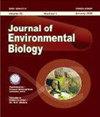Nano-curcumin ameliorates arsenic induced hepatotoxicity in female rats
IF 0.7
Q4 ENVIRONMENTAL SCIENCES
引用次数: 0
Abstract
Aim: To determine the protective effects of curcumin and nanocurcumin against arsenic-induced hepatotoxicity in female rats, using liver function tests and oxidative stress parameters. Methodology: Arsenic trioxide (4 mg kg-1 b.wt.), curcumin and nano curcumin (50 mg kg-1 b.wt.) were administered to healthy rats as a chronic treatment for 60 days through gavage. The liver tissue samples of exposed rats were examined for histopathological alterations, liver function tests viz. alanine transaminase (ALT), aspartate aminotransferase (AST), alkaline phosphatase (ALP), lactate dehydrogenase (LDH), bilirubin (BIL) and a lipid peroxidation product-malonaldehyde (MDA). Results: Treatments with both forms of curcumin could significantly (p 0<0.05) improve liver function as indicated by serum enzyme biomarkers viz. AST, ALT, ALP and LDH. Hyper-bilirubinemia was also diminished. Fibro-proliferation caused by arsenic in the liver was also controlled by curcumin (s). Histopathological observations of liver showed significant improvement in its morphology post treatments. Interpretation: Present results suggest that curcumin and nanocurcumin both express hepatoprotective effects in arsenic treated rats. However, nanocurcumin was found to offer better protection than curcumin. Key words: Arseniasis, Fibrosis, Lipid peroxidation, Liver function, Nanocurcumin纳米姜黄素能改善雌性大鼠砷诱导的肝毒性
目的:利用肝功能检测和氧化应激参数,确定姜黄素和纳米姜黄素对雌性大鼠砷诱导的肝毒性的保护作用。研究方法给健康大鼠灌胃三氧化二砷(4 毫克/千克-1 体重)、姜黄素和纳米姜黄素(50 毫克/千克-1 体重)作为慢性治疗,为期 60 天。对暴露大鼠的肝组织样本进行组织病理学改变、肝功能检测,即丙氨酸转氨酶(ALT)、天门冬氨酸氨基转移酶(AST)、碱性磷酸酶(ALP)、乳酸脱氢酶(LDH)、胆红素(BIL)和脂质过氧化产物--丙二醛(MDA)。结果:两种姜黄素都能明显改善肝功能(p 0<0.05),血清酶生物标志物即谷草转氨酶(AST)、谷丙转氨酶(ALT)、谷草转氨酶(ALP)和乳酸脱氢酶(LDH)均能说明这一点。高胆红素血症也有所减轻。姜黄素(s)还能控制砷在肝脏中引起的纤维增生。对肝脏的组织病理学观察显示,治疗后肝脏的形态有明显改善。解释:目前的研究结果表明,姜黄素和纳米姜黄素对砷处理过的大鼠都有保肝作用。然而,纳米姜黄素比姜黄素具有更好的保护作用。关键词砷中毒 肝纤维化 脂质过氧化 肝功能 纳米姜黄素
本文章由计算机程序翻译,如有差异,请以英文原文为准。
求助全文
约1分钟内获得全文
求助全文
来源期刊

Journal of environmental biology
ENVIRONMENTAL SCIENCES-
CiteScore
1.70
自引率
0.00%
发文量
92
审稿时长
3 months
期刊介绍:
Information not localized
 求助内容:
求助内容: 应助结果提醒方式:
应助结果提醒方式:


